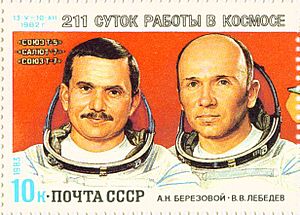Soyuz T-5 facts for kids
| Mission duration | 106 days, 5 hours, 6 minutes, 11 seconds |
|---|---|
| Spacecraft properties | |
| Spacecraft type | Soyuz-T |
| Manufacturer | NPO Energia |
| Launch mass | 6,850 kilograms (15,100 lb) |
| Crew | |
| Crew size | 2 up 3 down |
| Launching | Anatoli Berezovoy Valentin Lebedev |
| Landing | Leonid Popov Aleksandr Serebrov Svetlana Savitskaya |
| Callsign | Эльбру́с (Elbrus) |
| Start of mission | |
| Launch date | May 13, 1982, 09:58:05 UTC |
| Rocket | Soyuz-U |
| Launch site | Baikonur 1/5 |
| End of mission | |
| Landing date | August 27, 1982, 15:04:16 UTC |
| Landing site | 225 kilometres (140 mi) E of Dzhezkazgan |
| Orbital parameters | |
| Reference system | Geocentric |
| Regime | Low Earth |
| Perigee | 190 kilometres (120 mi) |
| Apogee | 231 kilometres (144 mi) |
| Inclination | 51.6 degrees |
| Period | 89.7 minutes |
| Docking with Salyut 7 | |
 Elbrus crew Soyuz programme
(Crewed missions) |
|
Soyuz T-5 was an important space mission in 1982. It was the first time astronauts visited the brand new Salyut 7 space station. The mission lasted for over 100 days.
While the Soyuz T-5 spacecraft was connected to Salyut 7, it received visits. An uncrewed supply ship called Progress 13 brought new items. Two other crewed missions, Soyuz T-6 and Soyuz T-7, also visited the station.
The first crew, known as the "Elbrus crew," launched a special amateur radio satellite. The Soyuz T-6 mission brought a French astronaut to the station. The Soyuz T-7 mission was special because it included the first woman in space in 20 years.
Soyuz T-5 launched with two astronauts. It returned to Earth with three astronauts. This was possible because different Soyuz spacecraft could dock with Salyut 7 at the same time.
Contents
Meet the Astronauts
Soyuz T-5 Launch Crew
| Position | Crew | |
|---|---|---|
| Commander | Only spaceflight |
|
| Flight Engineer | Second and last spaceflight |
|
These two astronauts were the first to fly the Soyuz T-5 mission. They were known as the "Elbrus crew."
Backup Crew Members
| Position | Crew | |
|---|---|---|
| Commander | ||
| Flight Engineer | ||
These astronauts were ready to fly if the main crew could not.
Soyuz T-5 Landing Crew
| Position | Launching crew | Landing crew |
|---|---|---|
| Commander | Third and last spaceflight |
|
| Flight Engineer | First spaceflight |
|
| Research Cosmonaut | First spaceflight |
These three astronauts returned to Earth aboard the Soyuz T-5 spacecraft. They were called the "Dnieper crew."
Mission Highlights
This mission was the very first trip to the new Salyut 7 space station. Salyut 7 was launched into orbit earlier in 1982. It was similar to the older Salyut 6 station but had some cool new features. One big improvement was that Salyut 7 had hot water available all the time!
Launching a Satellite
On May 17, 1982, the Elbrus crew did something amazing. They launched a 28-kilogram amateur radio satellite from a special airlock on Salyut 7. This was the first time a communications satellite was launched from a crewed spacecraft. It showed how advanced Soviet space technology was.
Working with Progress 13
A supply ship called Progress 13 docked with Salyut 7. On May 25, the crew moved the station so that the Progress ship's back end pointed towards Earth. This helped the station stay stable using gravity. Astronaut Lebedev wrote in his diary that the station's control jets were "very noisy." He said they sounded like "hitting a barrel with a sledgehammer."
Lebedev also compared unpacking Progress 13 to "getting ready to move or have just moved to a new apartment." The crew helped pump fuel from Progress 13 to Salyut 7. They also organized all the new supplies. On May 31, Progress 13 delivered 300 liters of water to the station.
Growing Plants in Space
In July, astronaut Valentin Lebedev was in charge of plant experiments. He reported that Arabidopsis plants had flowered and produced seeds in space. These plants were chosen because they grow quickly, in about 40 days. This was a world record! It was the first time plants had completed their full life cycle in zero gravity.
Returning to Earth
The Soyuz T-5 spacecraft undocked from Salyut 7 in August 1982. It left the Salyut 7 station and the Soyuz T-7 spacecraft in orbit. The Soyuz T-5 then successfully returned to Earth.
The "Dnieper crew" of Popov, Serebrov, and Savitskaya were on board for the landing. The Soyuz T-5 spacecraft had been in space for about six weeks. The original "Elbrus crew" stayed on Salyut 7 and returned to Earth later in December 1982, using the Soyuz T-7 spacecraft.
Images for kids
See also
 In Spanish: Soyuz T-5 para niños
In Spanish: Soyuz T-5 para niños



